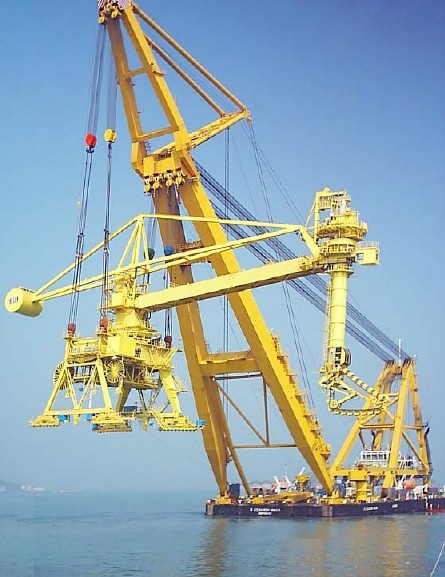|
+ Cranes
-Port Cranes -Shipyard Cranes + Steel Structures + Spare Parts + Shipping Service + Port Engineering
CMC INTERNATIONAL
Changzhou Cranes Mechanical Electrical Engineering Co., Ltd. Sandy(Manager) Mobile no. 0086-18001505166 Tel: +86-519-81886887 Fax: +86-519-85163887 Add: No.8-20 Shunyuan road, Xinchen industrial park, Xuejia town, Xinbei district, Changzhou city, Jiangsu province, P.R.China. Postalcode: 213125 Email: kaison1110@qq.com craneschina@gmail.com info@craneschina.cn |
 Floating crane barge, also called crane vessel, crane ship or floating crane is a ship that is specialized in carrying out high-standard harbour projects, as well as for loading-unloading, transhipping assignments and transportation of heavy loads. The largest floating cranes are often used for offshore construction. The larger floating crane barges are often semi-submersibles, but also conventional monohulls are used. The floating crane with a sheerleg built on barges for construction and salvaging sunken objects can be adpted to working enviroment with rotation characters. The floating barge is normally all welded steel construction. The barge¡¯s accommodation is to be located on fore main deck. The main hull can be divided into the following compartments: 1) Forepeak 2) Accommodation space 3) Machinery room with fuel oil bottom tanks, dirty oil tank and bilge tank etc. 4) Workshop & Machinery store 5) Ballast tanks and voids 6) Thruster room 7) Winch compartments 8) Afterpeak The accommodation space is to consist of: 1) Changing Room 2) Galley 3) Provision Store 4) Laundry 5) Mess Room/Recreation Room 6) Wash Place 7) Cabins 8) Emergency generator Room The control room, paint store and battery room are to be located on main deck. Stands followed during design and manufacturing processes: a) ABS Rules for Classification and Building of Steel Barges b) ABS Rules for Classification of Mobile Offshore Units. c) International Loadline Convention d) Maritime Laws and Regulations e) IMO intact and Damage Stability Guideline f) International Convention of Prevention of collisions at Sea g) International Tonnage Admeasurement Convention h) Marpol 73/78 i) Marine Laws and Regulations of the flag authority. |
Email:craneschina@gmail.com kaison1110@qq.com Mobile no. 0086-18001505166 Tel:+86-519-519-81886887 Fax:+86-519-85163887
Copyright © 2004 - 2019 CMC INTERNATIONAL ICP: 12027535 Power By: HONET ËÕICP±¸12027535ºÅ